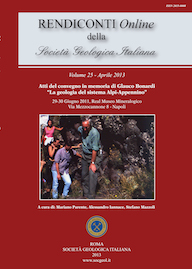
Link between thrust tectonics and sedimentation processes of stratigraphic sequences from the southern Apennines foreland basin system, Italy
Salvatore Critelli (*), Francesco Muto (*), Vincenzo Tripodi (*) & Francesco Perri (*)
(*) Dipartimento di Scienze della Terra, Università della Calabria, Ponte Pietro Bucci 87036 - Arcavacata di Rende, Cosenza, Italy. E-mail: critelli@unical.it
Volume: 25/2013
Pages: 21-42
Abstract
We discuss here tectonics and sedimentation processes occurring during continent-continent collision and relationships between accretionary processes on overplate, flexural lithosphere on underplate and related controls on clastic sedimentation in developing foreland basin systems. This paper focuses on and clastic sedimentation developed during the sequential history of the southern Italy orogenic system. These clastic trends, covering a large time span from pre-collisional Early Mesozoic to the present, may contribute: (1) to the paleogeographic and paleotectonic reconstructions of the southern Italy portions of the western Mediterranean orogen, and (2) to the general models of complex relationships between clastic sedimentation and paleotectonic history of other major orogens. The evolutionary record of Earth’s processes preserved in the form of sedimentary rocks has been pivotal in paleogeographical and paleotectonic reconstructions of source/basin systems. Compositional trends of clastic strata through space and time are used to infer the structural history of adjacent mountain belts and to monitor the key geodynamic changes during orogenic processes (e.g. Dickinson, 1985, 1988; Critelli & Ingersoll, 1994; Critelli, 1999). The controls on the composition and dispersal pathways of clastic strata along the convergent plate margins have long been debated (e.g. Dickinson, 1988; Ingersoll et alii, 1995). Clastic infilling of sedimentary basins in orogenic systems have been used as important indicators of tectonic activity and climatic changes. In the orogenic systems, clastic sedimentation may record the accretionary processes, the accomodation of the thrust units, and the flexural features of the foreland plate. The development of an orogenic wedge during continental collision results in thickening of the crust. The excess mass of this thickened crust acts as a load on the underthrust plate, causing it to be flexed downwards close to the load, so developing a foreland basin (e.g. Beaumont, 1981; Sinclair and Allen, 1992). During plate convergence, the vertically acting load of the mountain belt migrates over the foreland plate, thus resulting in the migration of the associated foreland basin. The foreland is the region between the front of a thrust belt and the adjacent craton (e.g. Dickinson, 1974; Bally and Snelson, 1980; Allen et alii, 1986; Miall, 1995). Large volumes of clastic sediment are derived from erosion of the thrust belt and deposited in the foreland basin. The foreland basin generally is defined as an elongate trough that forms between a linear contractional orogenic belt and the stable craton, mainly in response to flexural subsidence caused by thrust-sheet loading in the orogen.
Foreland basin stratigraphy records tectonic, eustatic, and climatic changes at convergent plate margins (e.g. Miall, 1995). The formation of unconformities is the results of the interplay of temporal variations in the erosion and lateral progradation rates of the orogenic wedge, as well as tectonic and eustatic sea-level changes (e.g. Beaumont, 1981; Jordan, 1981; Schedl & Wiltsc hko, 1984; Peper et alii, 1995).
Keywords
Foreland Basins, tectonics and sedimentation, stratigraphic evolution, provenance, Southern Apennines
Get Full Text